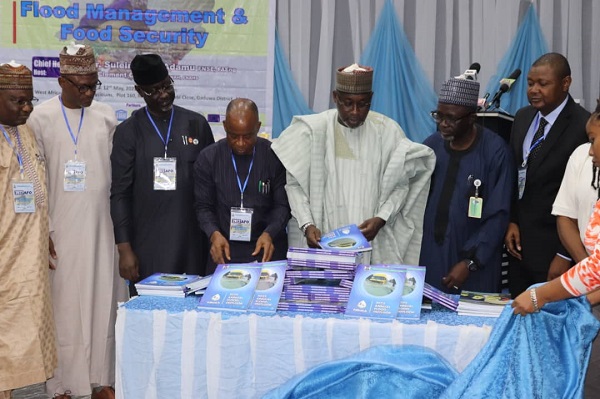
The Minister of Water Resources, Engr. Suleiman Adamu has highlighted that 32 states of the Federation, including the Federal Capital Territory (FCT), fall within the high risk of flood ranking for 2022.
He made this known during the official presentation of the 2022 Annual Flood Outlook (AFO) at the 10th edition of the Nigeria Hydrological Services Agency (NIHSA) tagged “Flood management and food security”, tailored toward achieving sustainable flood management practices and food security in the nation, today (May 12, 2022) in Abuja.
The minister said the AFO aids the abatement of flood risks in the country and, building upon the past successes, the agency has improved on its predictive capacity through the introduction of a new approach to the 2022 AFO.
“This new approach involves disaggregation of expected annual flood events into three different scenarios – Flood Outlook for April – June, Flood Outlook for July – September and Flood Outlook for October – November,” he said.
Adamu further said the goal is to translate these scenarios into a more dynamic flood forecast to showcase the peculiarity of different periods.
He emphasised that the breakdown of the 2022 AFO shows 233 local government areas in 32 states of the Federation (and the FCT) fall within the highly probable flood risks areas, 212 LGAs in 35 states of the Federation (including the FCT) fall within the moderately probable flood risks areas, while the remaining 329 LGAs falls within the probable flood risk areas. The highly probable flood risk states include Adamawa, Abia, Akwa Ibom, Anambra, Bauchi, Bayelsa, Benue, Cross River, Delta, Ebonyi, Ekiti, Edo, Gombe, Imo, Jigawa, Kaduna, Kano, Kebbi, Kogi, Kwara, Lagos, Nasarawa, Niger, Ogun, Ondo, Osun, Oyo, Rivers, Sokoto, Taraba, Yobe, Zamfara and the FCT.
Also, the minister said that climate change will continue to increase the intensity of rains and this will accelerate the increase in the frequency of flooding events. In addition to vigorous sensitisation through AFO publications and other non-structural measures (including strong advocacy on the part of the Federal and state governments) and the establishment of flood early warning systems at flood hot-spots, the Federal Ministry of Water Resources is putting up structural control measures such as dams, canals, dykes, storm drains and other facilities to divert floodwaters from highly probable flood risk zones.
“On the international scene, we are reinforcing our collaboration with the neighbouring countries with regards to water releases from dams within their catchments and are much assured of better preparedness plans to avert any flood eventual incidents,” he said.
Earlier, the NIHSA director-general, Engr. Clement Nze, urged citizens to comply with the environmental guidelines and town planning regulations to avoid flood disasters within the country.
He added that the overall objective of the event is to sensitise the nation, particularly planners, decision and policymakers, farmers, stakeholders and the general public on the need to embark on preventive measures to improve safety and reduce potential damages to lives and property from the flood events and to increase enlightenment and sensitisation campaigns for better preparedness on flood mitigation and management, particularly in the Flood risk zones all over the country.
The NIHSA boss stressed that the essence of the annual flood outlook produced by the Nigeria Hydrological Service Agency is to give any information to the general public about what the flooding pattern is meant to be in the year and what the government and individuals need to do to avert the destructive part of the flooding.
“The annual flood outlook which commenced in 2013 is to prepare the nation to take proactive measures to ensure that the negative impact of flooding is averted. This AFO was a result of circumstances after the 2012 flood incident in Nigeria. The essence is to prepare the nation. A flood is a potential hazard but when it is not properly managed, it translates to disaster.
“What we are doing by the AFO is trying to enquire, through a scientific approach, what is going to happen. Rainfall is a major agent of flooding. In other words, if there is no rainfall, do not expect flooding to occur.
“I recall in 2020, the flood in Kebbi State was quite devastating. Kebbi State is the first point of entry of River Niger into Nigeria. When crops are washed away by flood or farmers are made to harvest earlier than necessary because of the flood, there are a lot of implications for food security. Like in Kebbi, almost 450 hectares of rice farms were washed away. It also happened in Jigawa and Anambra states. So, it has implications. By and large, a flood has a lot of implications on food security.
“There is no gainsaying that the accuracy of the AFO predictions has been of internationally accepted standard and reliable. However, the focus is on the prevention and mitigation of possible flood disasters through increasing its visibility on the part of the populace and prompting them to take appropriate preventive, adaptive and mitigative measures, as well as encouraging them to comply with environmental guidelines and town-planning regulations,” he added.

